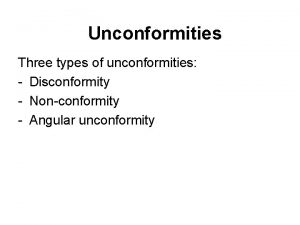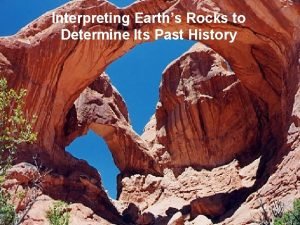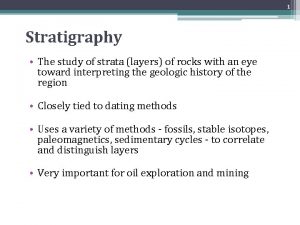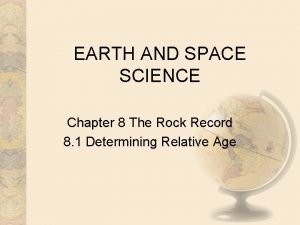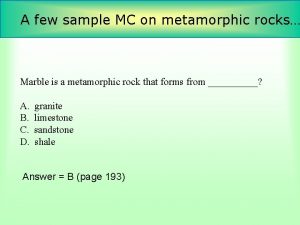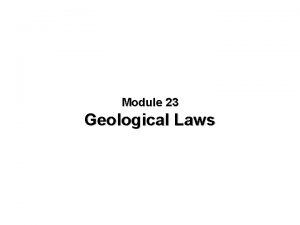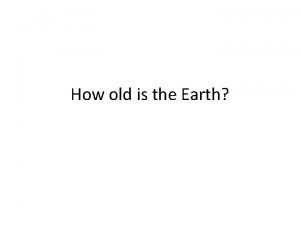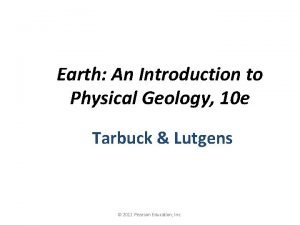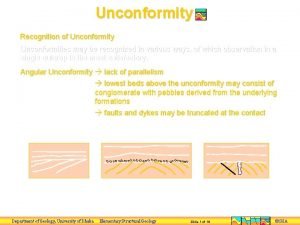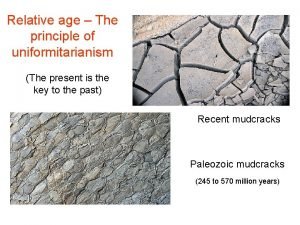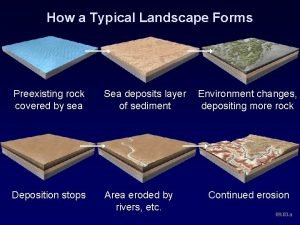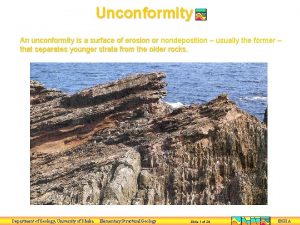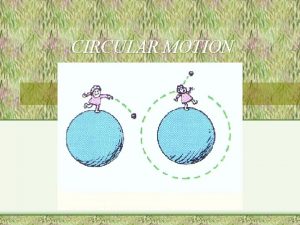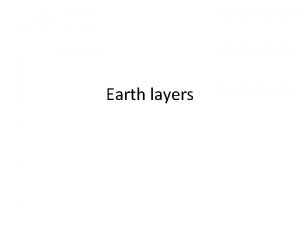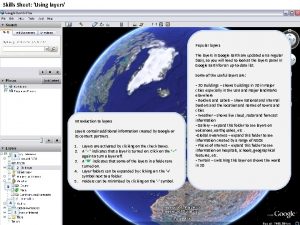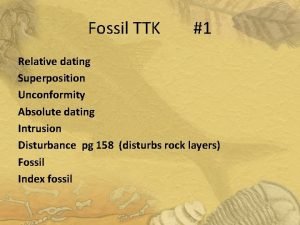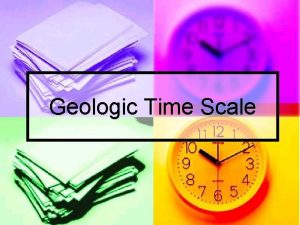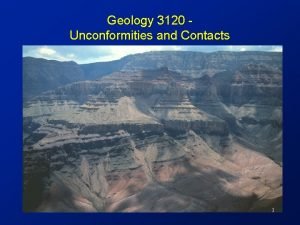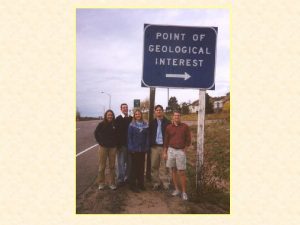Unconformities 3 Angular unconformity the upper layers overlie






































- Slides: 38

Unconformities 3. Angular unconformity – the upper layers overlie lower beds that have been folded by tectonic processes & then eroded to a more or less even plane. The 2 sets of layers are not parallel to each other.

Angular Unconformity

Angular Unconformity: Ojito Wilderness, NM Photos: L. Brown 7 -7 -11

Using the Principles to Determine Relative Age • Now we can put these principles together to determine the relative age of rocks.

Measuring Absolute Time • An absolute age can be determined by measuring the rate of radioactive decay of isotopes. • Remember an isotope is an atom with different numbers of neutrons.

Measuring Absolute Time • Original radioactive isotopes, called parent isotopes, decay into stable isotopes (daughter isotopes) by the process of fission. • During fission, one atom splits into 2 or more atoms.

Measuring Absolute Time • Radioactive isotopes decay at a set rate that is different for each isotope. • The amount of parent isotopes is set at 100% at the time the rock formed, so we can look at the ratio of parent to daughter isotopes to determine how much time has passed.

Measuring Absolute Time • You’ll never know which atoms will decay. . . (16 atoms)


… or when. . .

But one thing we do know. . .

. . . is that it always takes the same amount of time for half to disappear. (8 atoms)

Half-Life • The isotope decays at a constant rate that is measured by the isotope’s half-life. • Half-life is the time it takes for half of the parent isotopes to decay into daughter isotopes. • In other words, half- life is the measure that we use to determine the age of the rock.

• Each half-life, the amount of radioactive parent isotopes gets cut in half.

• One half-life.

• Two half-lives.

• Three half-lives.

• Four half-lives.

• Since you don’t know how many isotopes you started with, a ratio between parent to daughter will tell you how many half-lives have gone by. 100% parent 0% daughter 0 half lives

• One half-life. 50% parent 50% daughter 1 half-life

• Two half-lives. 25% parent 75% daughter 2 half-lives

• Three half-lives. 12. 5% parent 87. 5% daughter 3 half-lives

• Four half-lives. 6. 25% parent 93. 75% daughter 4 half-lives

Radioactive Isotopes Used in Dating

The Geologic Time Scale • Divides Earth’s history into intervals marked by a distinctive set of fossils. • Boundaries between the intervals of time are marked by abrupt changes in the fossil record.

The Geologic Time Scale • The time scale was first created using principles of relative dating • The absolute ages of the boundaries were later determined by radioactive dating, and are subject to change as the absolute ages are refined when new data is discovered.

Divisions of the Geologic Time Scale • The time scale is broken into the following intervals, from largest to smallest: • Eons • Eras • Periods • Epochs

The Geologic Time Scale

Boundaries of the Geologic Time Scale • The major boundaries represent mass extinctions – short intervals of time when many species disappeared from the geologic record, followed by the blossoming of many new species.

The K-T Boundary • In some cases we think we know the cause of extinction. • Ex: the Cretaceous-Tertiary (K-T) boundary. In mass extinctions at end of Cretaceous, 75% of the living species, including dinosaurs, were killed off. This was almost certainly due to a meteorite impact that darkened the skies and caused Earth to become bitterly cold.

The Permian Extinction • In other cases, we are not sure of the cause of extinction. • Ex: the largest mass extinction took place at the end of the Permian, when 95% of all species were killed. Possibilities of extinction include formation of Pangaea, abrupt climate changes, meteorite impact or a huge volcanic eruption in Siberia.

Precambrian • The part of the time scale before the Cambrian period, known as the Precambrian, had a duration of over 4000 million years. • This comprises 9/10 of Earth’s entire history! • The Precambrian includes the Hadean, Archean & Protorozoic eons.

Phanerozoic • The Phanerozoic eon makes up the remaining 1/10 of Earth’s history. • The boundary between the Precambrian & Phanerozoic is marked by the first appearance of shelly fossils (i. e. , fossils with hard parts). All life before the phanerozoic was soft-bodied.

Hadean Eon • 4. 6 Ga – 3. 9 Ga. • Began with Earth’s formation • Earth was bombarded by meteorites. • Very few rocks survive from this time, but individual mineral grains 4. 4 billion years old have been found.

Archean Eon • • 3. 9 – 2. 5 Ga. Climate system was established 1 st continental masses formed Life in form of primitive unicellular microorganisms

Proterozoic Eon • 2. 5 Ga – 542 Ma • Plate tectonics & climate operating as today • Organisms increased oxygen in atmosphere • Life still soft-bodied

Phanerozoic Eon • 542 Ma - present • Beginning of this eon is marked by the 1 st appearance of shelly fossils. • Humans have been present for only the last tiny bit of geologic time.

History of universe compared to a calendar year Image: http: //www. horton. ednet. ns. ca/staff/webb/geology/Geological%20 Time. html
 Three types of unconformities
Three types of unconformities Law of inclusions
Law of inclusions Angular unconformity
Angular unconformity Angular unconformity
Angular unconformity Ggtth meaning
Ggtth meaning Unconformities
Unconformities What is stratigraphy
What is stratigraphy Three types of unconformities
Three types of unconformities Angular impulse-angular momentum theorem
Angular impulse-angular momentum theorem Unconformity
Unconformity Module 23
Module 23 Lateral continuity
Lateral continuity Unconformity
Unconformity Recognition of unconformity
Recognition of unconformity Relative age
Relative age Unconformity
Unconformity Tỉ lệ cơ thể trẻ em
Tỉ lệ cơ thể trẻ em Thế nào là mạng điện lắp đặt kiểu nổi
Thế nào là mạng điện lắp đặt kiểu nổi Lời thề hippocrates
Lời thề hippocrates Vẽ hình chiếu đứng bằng cạnh của vật thể
Vẽ hình chiếu đứng bằng cạnh của vật thể Quá trình desamine hóa có thể tạo ra
Quá trình desamine hóa có thể tạo ra Môn thể thao bắt đầu bằng từ đua
Môn thể thao bắt đầu bằng từ đua Sự nuôi và dạy con của hươu
Sự nuôi và dạy con của hươu Hát kết hợp bộ gõ cơ thể
Hát kết hợp bộ gõ cơ thể Các loại đột biến cấu trúc nhiễm sắc thể
Các loại đột biến cấu trúc nhiễm sắc thể điện thế nghỉ
điện thế nghỉ Biện pháp chống mỏi cơ
Biện pháp chống mỏi cơ Trời xanh đây là của chúng ta thể thơ
Trời xanh đây là của chúng ta thể thơ Phản ứng thế ankan
Phản ứng thế ankan Gấu đi như thế nào
Gấu đi như thế nào Thiếu nhi thế giới liên hoan
Thiếu nhi thế giới liên hoan Tia chieu sa te
Tia chieu sa te Một số thể thơ truyền thống
Một số thể thơ truyền thống Thế nào là hệ số cao nhất
Thế nào là hệ số cao nhất Slidetodoc
Slidetodoc Hệ hô hấp
Hệ hô hấp Số nguyên tố là gì
Số nguyên tố là gì đặc điểm cơ thể của người tối cổ
đặc điểm cơ thể của người tối cổ Cách giải mật thư tọa độ
Cách giải mật thư tọa độ
